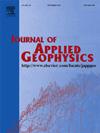Numerical study on the characteristics of guided waves in shallow marine environment
IF 2.2
3区 地球科学
Q2 GEOSCIENCES, MULTIDISCIPLINARY
引用次数: 0
Abstract
The determination of shallow S-wave velocity in marine surveys relies predominantly on the dispersion inversion of Scholte waves, analogous to Rayleigh wave applications in land situations. To determine shallow P-wave velocities, the dispersion nature of guided waves can be utilized. While theoretical frameworks for dispersion curve computation have been established, wavefield analysis about guided waves remains underdeveloped. This study employs finite-difference modelling to systematically investigate guided wave propagation characteristics and multimodal dispersion patterns across diverse shallow marine stratigraphic configurations. The simulation results reveal that the guided-wave dispersion images have to face high ambiguity in defining mode types and numbers. As a result, this ambiguity leads to an underestimation of P-wave velocity and errors in depth. Furthermore, the relative change in dispersion spectra in response to variations of the different parameters also provides evidence that guided waves formed in marine situations are more complex, particularly related to the velocity contrast ratio between the minimum S-wave velocity and the P-wave velocity in water. Guided waves are sensitive to both the variation of the S- and P-wave velocity except for a soft model in which guided waves are formed by purely P-related waves. Correct mode identification and reasonable initial model building are key steps to ensure the inversion accuracy. The mode misidentification and low sensitivity of picked phase velocities to the inverted parameter significantly increase the inversion uncertainty, thereby reducing confidence in the final results. It reminds us to pay extra attention to this phenomenon when prior underground information is available.
求助全文
约1分钟内获得全文
求助全文
来源期刊

Journal of Applied Geophysics
地学-地球科学综合
CiteScore
3.60
自引率
10.00%
发文量
274
审稿时长
4 months
期刊介绍:
The Journal of Applied Geophysics with its key objective of responding to pertinent and timely needs, places particular emphasis on methodological developments and innovative applications of geophysical techniques for addressing environmental, engineering, and hydrological problems. Related topical research in exploration geophysics and in soil and rock physics is also covered by the Journal of Applied Geophysics.
 求助内容:
求助内容: 应助结果提醒方式:
应助结果提醒方式:


